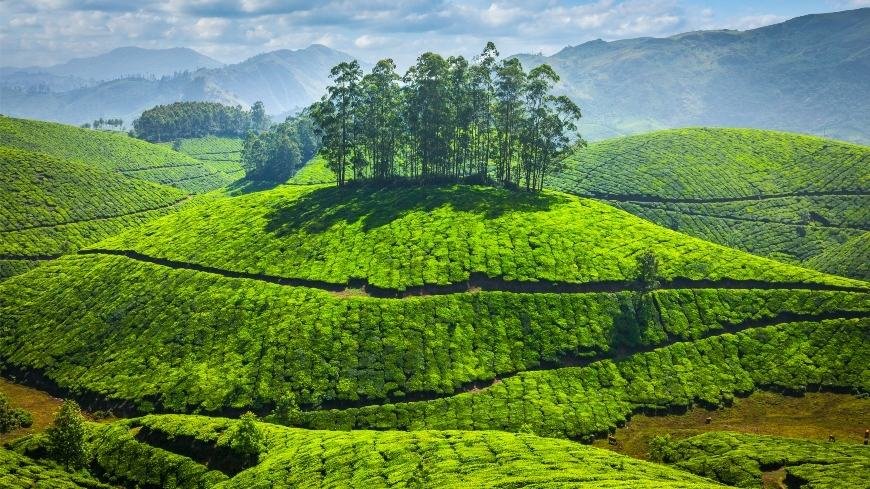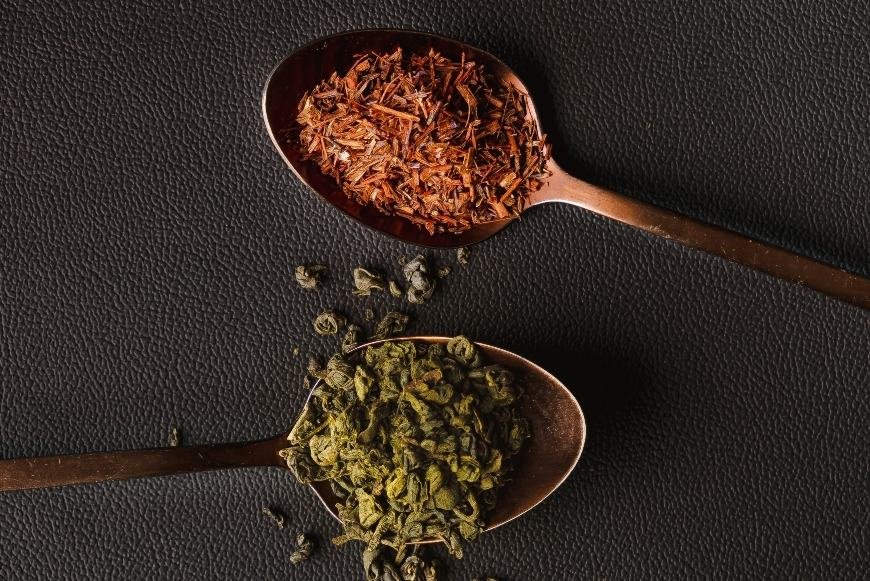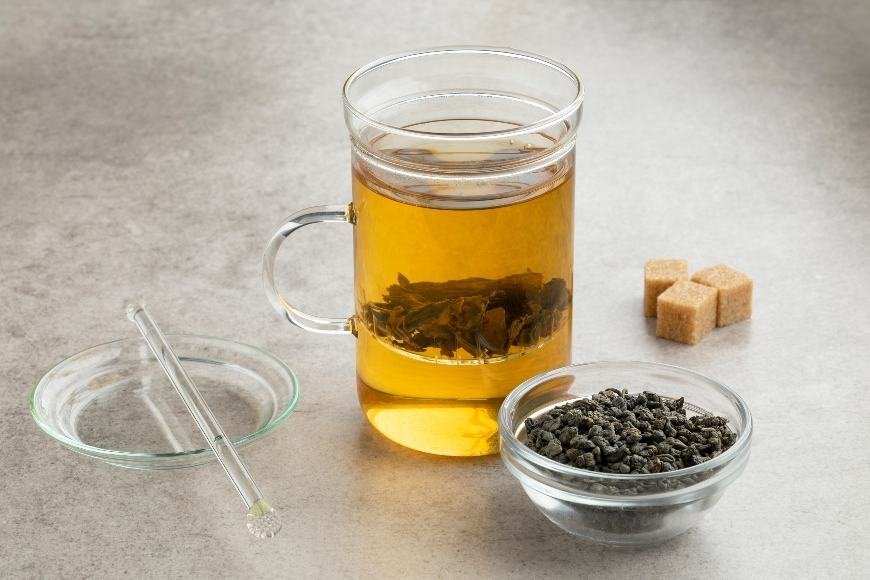How is Gunpowder Tea Made?
Uncover how gunpowder tea is made, from growing to brewing this popular green tea. Explore the secrets behind its unique flavor and aroma!

Ever wondered how gunpowder tea is made? This special, sought-after green tea has a long past that dates back to the Tang Dynasty of China. In this blog post, we'll explore the intricate process of creating gunpowder green tea - from cultivating and harvesting to processing and brewing.
You'll learn about cultivating gunpowder tea plants, including factors that influence their growth. We will also explore the careful art of harvesting these precious leaves at just the right time for optimal flavor. Next, we will discuss various methods used in processing gunpowder tea leaves before they are transformed into tiny pellets resembling black powder.
Furthermore, you'll discover how rolling techniques impact both appearance and taste of your favorite cup of gunpowder green tea. Finally, we will cover proper storage practices to maintain freshness as well as tips on brewing a perfect cup of this flavorful beverage. So sit back with your teacup in hand as we embark on an enlightening journey through the world of gunpowder tea making!
Table of Contents:
- Growing Gunpowder Tea
- Harvesting Gunpowder Tea
- Storing Gunpowder Tea
- Frequently Asked Questions How is Gunpowder Tea Made?
- Conclusion
Growing Gunpowder Tea
Gunpowder tea, a popular type of green tea, is known for its unique appearance and strong flavor. Growing your own gunpowder tea plants can be an exciting and rewarding experience. This section will provide guidance on the process of cultivating gunpowder tea plants successfully.
1. Choose the Right Seeds or Seedlings
To start growing gunpowder tea, you'll need to choose high-quality seeds or seedlings from a reputable source. Make sure they are specifically labeled as "gunpowder" or "pellet" green tea varieties.
2. Prepare the Soil and Planting Area
Gunpowder tea plants thrive in well-draining soil with a pH between 6 and 6.5. You can test your soil's pH using a soil testing kit. If needed, amend the soil with organic matter such as compost or peat moss to improve drainage and adjust pH levels.
- Select an area that receives partial shade throughout the day since excessive sunlight may cause leaf scorching.
- If planting multiple seedlings, space them at least three feet apart to allow room for growth.
- Dig holes twice as wide but just as deep as each plant's root ball before placing them into their respective holes gently.
- Cover roots completely with amended soil without burying the stem.
3. Water and Fertilize Regularly
Keep the soil consistently moist but not waterlogged, watering deeply once or twice a week depending on weather conditions. A soil moisture sensor can help you monitor your plants' hydration needs accurately.
Fertilize gunpowder tea plants with an organic fertilizer high in nitrogen every four to six weeks during their growing season. This will promote healthy leaf growth and ensure optimal flavor when it's time to harvest your tea leaves.
4. Prune Your Plants for Optimal Growth
To encourage bushy growth and increase yield, prune your gunpowder tea plants regularly by pinching back new shoots after they have produced two sets of leaves. Remove any dead or yellowing foliage as needed to maintain plant health and prevent disease spread.
Growing gunpowder tea may require some patience, but following these steps will set you up for success in cultivating this unique green tea variety at home.
3. Harvesting Gunpowder Tea

If you're looking to grow and harvest your own gunpowder tea, it's essential to know the right time and method for harvesting the leaves. This will ensure that you get the best possible flavor from your homegrown tea. To ensure a successful harvest, we'll provide instructions on how to pick gunpowder tea leaves.
A. When to Harvest
The ideal time for harvesting gunpowder tea is during early spring when new shoots start appearing on the plant. These young leaves are tender and full of flavor, making them perfect for creating high-quality gunpowder tea.
- Look out for bright green buds with one or two small leaves attached - these are known as "pekoe" in traditional Chinese terminology.
- You can also harvest slightly older leaves (with three or four leaflets) if desired; however, they may have a stronger taste than younger ones.
- Avoid picking any yellowed or damaged foliage as this could affect overall quality and taste of your final product.
B. How to Harvest
To harvest gunpowder tea properly, follow these simple steps:
- Gently pluck each bud along with its attached leaflets using either your fingers or a pair of sharp scissors - be careful not to damage surrounding growth while doing so.
- Place harvested buds into a clean container such as a basket lined with paper towels - avoid stacking too many layers on top of each other as this could cause bruising which would negatively impact flavor later on.
- Once you've collected enough leaves, take them indoors to begin the processing stage (which we'll discuss in more detail in the next section).
Remember that harvesting gunpowder tea is a delicate process - it's important to handle your plants with care and patience. By adhering to these steps, you can make your own flavorful gunpowder tea.
4. Processing Gunpowder Tea Leaves
Once you've harvested your gunpowder tea leaves, it's time to process them for optimal flavor and quality. This stage is crucial in determining the final taste of your tea, so follow these detailed instructions carefully.
A. Withering the Leaves
The first step in processing gunpowder tea leaves is withering them to reduce their moisture content and make them more pliable for rolling later on. To do this, spread out the freshly picked leaves evenly on a clean surface or withering tray. Spread the recently gathered tea leaves on a clean surface or withering tray in an airy place away from direct sunlight and let them sit for around 6-8 hours until they become slightly limp.
B. Fixation (Kill-Green)
After withering, it's essential to stop any further oxidation by applying heat through a process called fixation or "kill-green." There are several methods you can use:
- Pan-firing: Heat a large wok or frying pan over medium heat and add small batches of withered leaves at a time. Stir continuously for about 5 minutes until they turn darker green and release their aroma.
- Oven-roasting: Preheat your oven to around 250°F (120°C) and place the withered leaves on baking sheets lined with parchment paper. Roast for approximately 20 minutes while turning occasionally to ensure even heating.
C. Rolling and Shaping the Leaves
If you've successfully grown, harvested, and processed your gunpowder tea leaves, the next step is to roll them into pellets for easy storage and brewing. This unique rolling technique not only gives gunpowder tea its name but also helps preserve the flavor and aroma of the leaves.
1. Traditional Hand-Rolling Method
The traditional method of rolling gunpowder tea involves using your hands to shape the leaves into small, tight pellets. Here's how:
- Place a small amount of processed tea leaves on a clean surface or in the palm of your hand.
- Gently press down on the leaves with your fingers while simultaneously rolling them between your palms in a circular motion.
- Continue this process until all the leaves are tightly rolled into small balls resembling black powder used in old-fashioned firearms (hence "gunpowder" tea).
2. Using a Bamboo Mat or Cloth
An alternative method for rolling gunpowder tea involves using a bamboo mat or cloth to help shape and compress the pellets more evenly:
Lay out a clean bamboo mat or cloth on a flat surface. Place some processed tea leaves onto it. Spread out the leaves evenly across the mat or cloth, ensuring they are not overlapping too much. Gently fold one edge over. Press down firmly and begin rolling the leaves into a tight cylinder. Repeat this process until all of your tea leaves have been rolled into pellets.
Rolling gunpowder tea leaves may be laborious, yet it is indispensable for safeguarding their taste and scent. The pleasure of crafting your own tea from the beginning to end is something that can't be denied.
D. Drying the Rolled Tea Leaves
The final step in processing gunpowder tea is drying the rolled leaves to remove any remaining moisture content. Spread out your pearls evenly on clean trays or screens and let them air-dry naturally for about 12 hours in a cool, well-ventilated area away from direct sunlight. An alternative to air-drying is oven-drying at a low temperature of 200°F/93°C for an hour until the pearls feel dry.
Processing Gunpowder Tea Leaves requires a lot of precision and care, as the leaves must be handled delicately to ensure that their flavor is preserved. Moving on from processing, rolling Gunpowder Tea Leaves is another important step in making this unique tea.
4. Storing Gunpowder Tea

Proper storage of gunpowder tea is essential to maintain its freshness, flavor, and potency over time. In this section, we will discuss the best practices for storing your precious gunpowder tea leaves.
Airtight Containers
To protect the flavor of your gunpowder tea, an airtight container is essential. This prevents exposure to air and moisture that can cause oxidation and degrade the taste of your tea. Glass jars with tight-fitting lids or metal tins are excellent options for keeping your gunpowder tea fresh.
Cool and Dark Environment
Heat and light can also negatively impact the quality of your stored gunpowder tea. To avoid these issues, store your airtight containers in a cool (below 25°C/77°F) and dark place such as a pantry or cupboard away from direct sunlight or heat sources like stoves or radiators.
Avoid Strong Odors
The porous nature of gunpowder pellets makes them susceptible to absorbing strong odors from their surroundings. Keep them away from items with pungent smells like spices or cleaning products by storing them separately in dedicated spaces within cabinets or drawers.
- Airtight Containers: Use glass jars with tight-fitting lids or metal tins for optimal preservation.
- Cool & Dark Environment: Store containers below 25°C (77°F) in areas without direct sunlight exposure.
- Avoid Strong Odors: Keep gunpowder tea away from pungent-smelling items to prevent absorption of unwanted odors.
In addition to these storage tips, it's also essential to handle your gunpowder tea with clean hands and utensils. This prevents contamination and ensures that you can enjoy the full flavor and aroma of your gunpowder tea for as long as possible.
Properly storing gunpowder tea is essential for maintaining its freshness and flavor. Now, let's look at how to brew the perfect cup of gunpowder tea.
Frequently Asked Questions How is Gunpowder Tea Made?
How is gunpowder tea made?
Gunpowder tea is made by growing, harvesting, and processing the Camellia sinensis plant. The leaves are then rolled into small pellets resembling gunpowder, which gives the tea its name. This rolling process helps to preserve flavor and aroma. Finally, the tea is dried and stored before being brewed for consumption.
How is gunpowder green tea produced?
Gunpowder green tea production involves plucking young leaves from the Camellia sinensis plant, followed by withering to reduce moisture content. The leaves are then pan-fired or steamed to prevent oxidation and maintain their green color. Afterward, they're tightly rolled into pellet shapes that resemble gunpowder grains before being dried completely.
What is the history of gunpowder tea?
The history of gunpowder tea dates back to China's Tang Dynasty (618-907 AD). It gained popularity during the Ming Dynasty (1368-1644) due to its long shelf life compared to other teas at that time. Gunpowdertea was introduced in Europe around 17th century through trade routes.
What is an important characteristic of gunpowdertea?
An important characteristic of gunpower teais its unique shape: tightly rolled pellets resembling old-fashioned black powder used in firearms.This compact form allows it to retain freshness and strong flavours longer than other tea varieties, making it a popular choice for long-term storage and transportation.
Conclusion
The production of gunpowder tea is intricate and demands tremendous perseverance. From growing the plant, to harvesting, processing, rolling and storing it properly before brewing - all these steps need to be followed carefully in order for you to enjoy your cup of freshly made gunpowder tea. With this guide we hope that you now have enough knowledge on how gunpowder tea is made so that you can make your own delicious cup at home.






































































































































